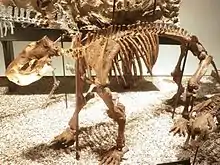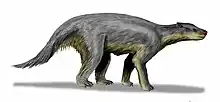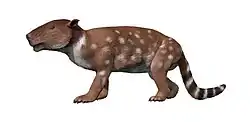Bemalambdidae
Bemalambdidae is an extinct family of pantodont mammals known from Early and Middle Paleocene of China.
| Bemalambdidae Temporal range: | |
|---|---|
 | |
| Skeleton of Bemalambda pachyoesteus, exhibited in the National Museum of Nature and Science, Tokyo, Japan. | |
| Scientific classification | |
| Domain: | Eukaryota |
| Kingdom: | Animalia |
| Phylum: | Chordata |
| Class: | Mammalia |
| Order: | †Pantodonta |
| Superfamily: | †Bemalambdoidea |
| Family: | †Bemalambdidae Chow et al. 1973 |
| Genera and species[1] | |
| |
Description
The bemalambdids are, along with Harpyodus and Alcidedorbignya, the most primitive pantodonts. Hypsilolambda is known only from a skull and teeth, but Bemalambda is known from complete cranial and postcranial specimens and is the best preserved mammal from Shanghuan. It was dog-sized (a large animal for its era) and omnivorous.[2]
Both genera have dilambdodont upper premolars (W-shaped crests on the crowns), one of the characteristics of pantodonts, but their upper molars, unlike in later pantodonts, are almost zalambdodont (V-shaped crests) and transversely elongated with the paracone and metacone (cusp) appressed or connated. On p3-M3, there is a large buccal platform on the crowns, the stylar shelf. An exterior indentation on the buccal side, the ectoflexus, is very deep. The lower cheek teeth are easily recognizable as pantodont.[3]
The bemalambdids had a low and short skull with a very small braincase; a prominent sagittal crest and deep temporal fossae, a broad snout; and flaring zygomatic processes. The high coronoid process on the mandible suggest the chewing musculatures was more developed than in later pantodonts. The postcranium was robust, and, judging from a single massive humerus, adapted for digging.[3]
Fossil localities
- the Early Paleocene (65.5 to 58.7 Ma) of Guangdong, China (type) (25.1°N 114.3°E, paleocoordinates 26.0°N 109.4°E)[4]
- the Early Paleocene (65.5 - 58.7 Ma) of Shaanxi, China[5]
- the Middle Paleocene (61.7 - 58.7 Ma) of Jiangxi, China[6]
Notes
- Bemalambdidae in the Paleobiology Database. Retrieved July 2013.
- Lucas 2001, p. 207
- Rose 2006, p. 114
- Linnania type, Nanxiong (Paleocene to China) in the Paleobiology Database. Retrieved July 2013.
- Shimen Commune (lower bed) (Paleocene of China) in the Paleobiology Database. Retrieved July 2013.
- 300 m SW of Fengshuxia (Paleocene of China) in the Paleobiology Database. Retrieved July 2013.
References
- Chow, M. M.; Chang, Y.-P.; Wang, B.-Y.; Ting, S.-Y. (1973). "New mammalian genera and species from the Paleocene of Nanhsiung, N. Kwangtung" (PDF). Vertebrata PalAsiatica (in Chinese and English). 11 (1): 31–35. Retrieved 17 July 2013.
- Li, Qian (2005). "New Material of Bamalamdba from Chijiang Basin in Jiangxi, China" (PDF). Vertebrata PalAsiatica (in Chinese and English). 43 (4): 325–329. Retrieved 17 July 2013.
- Lucas, Spencer G. (2001). Chinese Fossil Vertebrates. Columbia University Press. ISBN 9780231504614. Retrieved 17 July 2013.
- Rose, Kenneth David (2006). The beginning of the age of mammals. Baltimore: JHU Press. ISBN 0801884721.
- Wang, Banyue (1975). "Paleocene mammals of Chaling Basin, Hunan" (PDF). Vertebrata PalAsiatica (in Chinese). 13 (3): 154–62. Retrieved 17 July 2013.

